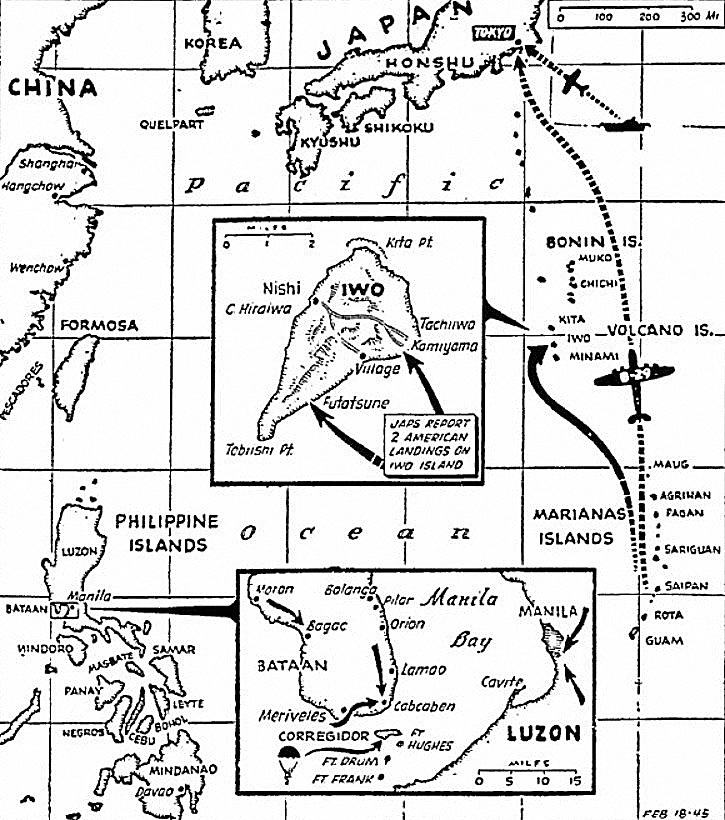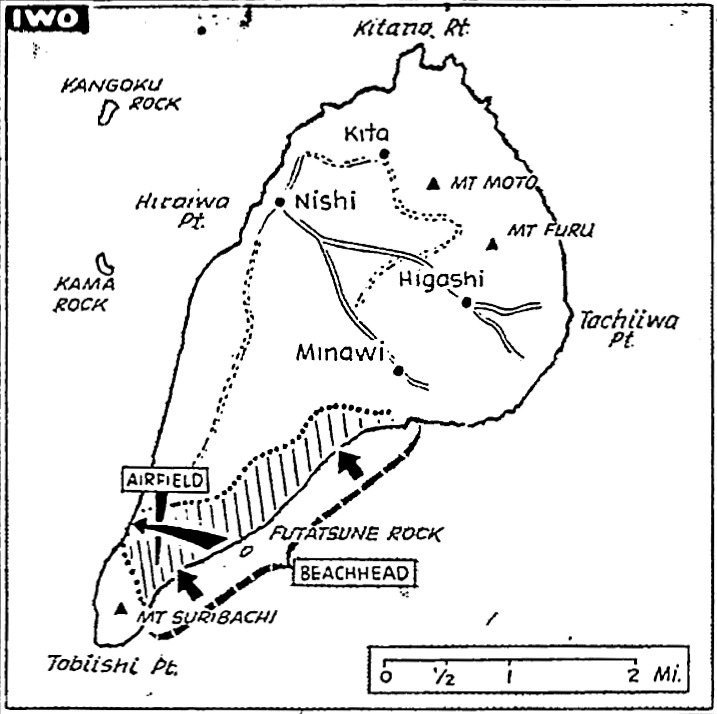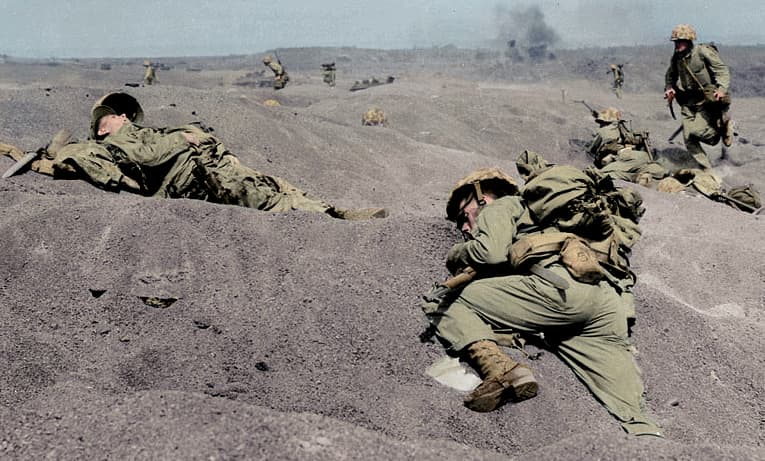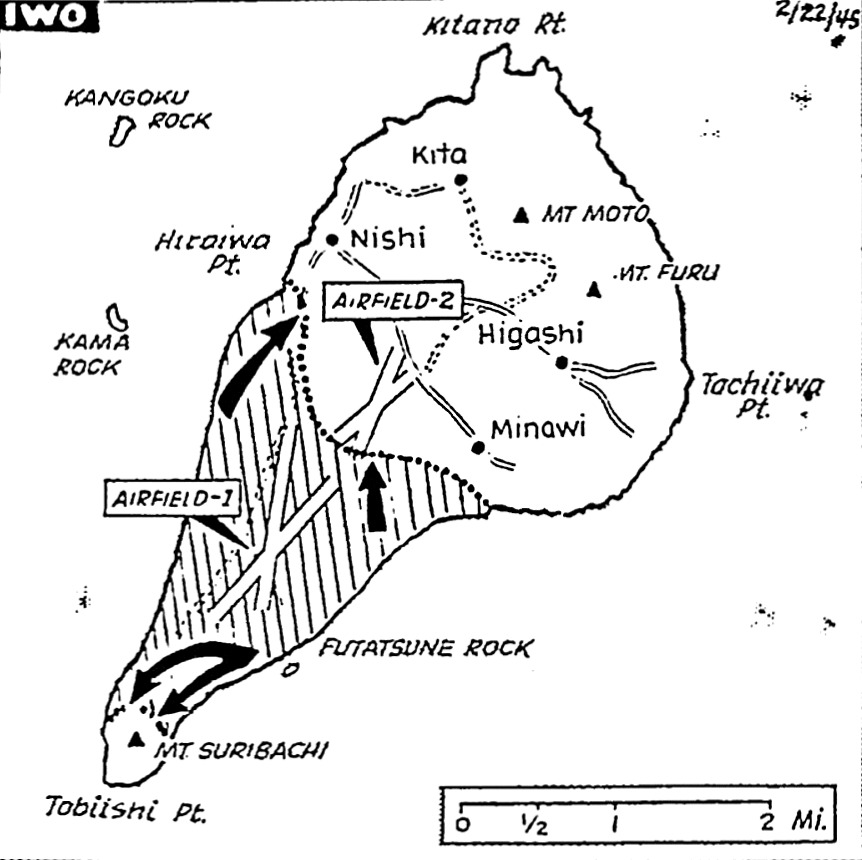The Pittsburgh Press (February 18, 1945)
Nimitz silent on reported Iwo landing
Says bombardment continues third day
Action in the Pacific included capture of most of Corregidor Island by Gen. MacArthur’s forces. Tokyo reported an American landing on Iwo Island, but Adm. Nimitz said merely that Iwo was being bombarded for the third day. Meanwhile, U.S. carrier planes carried their raid on Tokyo into a second day. U.S. troops served a surrender ultimatum to Jap troops holed up in Manila. Bataan Peninsula was captured by a combined U.S. landing at Mariveles and advances down the coasts.
PACIFIC FLEET HQ, Guam (UP) – Adm. Chester W. Nimitz announced today that a powerful American battle fleet had carried the bombardment of Iwo Island into a third day.
Tokyo claimed U.S. troops had begun invading that “doorstep” island to Japan, 750 miles south of the Nipponese capital.
U.S. ship damaged
A bulletin issued at 10:30 a.m. (7:30 p.m. Saturday ET) reported that one ship in a task force of Adm. Raymond A. Spruance’s U.S. Fifth Fleet had been damaged by “intense” Jap fire from Iwo, which was being blasted by naval artillery shells or airplane bombs for the 74th consecutive day.
Carrier planes of the attacking force strafed the Bonin Islands of Chichi and Haha north of Iwo, damaging 23 grounded planes and exploding an ammunition barge Friday. Warship anti-aircraft batteries shot down two Jap planes attacking the warship armada in what was the first announced enemy attempt to strike back.
A Berlin broadcast said that Jap headquarters in Tokyo announced that U.S. troops had invaded the Bonin Islands early Saturday. Berlin claimed the Japs damaged two U.S. troop transports and repulsed those landings.
The Bonins comprise 27 major islands, the northernmost of which lies 580 miles south of Tokyo.
Claim attempts repulsed
Tokyo claimed the Americans had attempted to land on the southeastern coast of Iwo at 10:30 a.m. Japanese Time Saturday (9:30 p.m. Friday ET), but were repulsed. Ten minutes later, another force battled ashore at a point two miles to the northeast, the enemy said, without adding at that time any claim to having repulsed it.
A later Tokyo broadcast warned Japan that the situation “warrants us no optimism” because U.S. warships were still massed offshore and “persistently watching for an opportunity to make a landing.”
‘Glorious victory’
The broadcast said the Jap garrison had scored a “glorious victory” in that “not a single enemy has been permitted to land on Iwo Jima yet,” but said “it is apparent that the enemy still has a reinforcement convoy behind him.”
None of Tokyo’s claims were confirmed by Adm. Nimitz although from the scope of the three-day operation it appeared momentous developments were at hand in the Battle of the Pacific.
Adm. Nimitz’s bulletin did not say whether attacks by some 1,200 carrier planes on the Tokyo-Yokohama area of Tokyo were continuing into the third day.
Further reports ‘unavailable’
“Further reports on the attacks on Tokyo by aircraft – are unavailable,” Adm. Nimitz said.
But Tokyo reported that the carrier planes attacked Japan for six hours yesterday – second day of the attack. A high officer here said a radio silence which had blacked out details of the Tokyo assault was “beautiful,” meaning that as long as the Japs did not attack the carriers and escorting warships the American commanders would not break silence.
Indicating the ferocity of the attacks, however, Tokyo admitted it lost 61 planes over the homeland and claimed to have downed or damaged 250 U.S. planes.
Battleships and cruisers
Of the assaults on Iwo, Adm. Nimitz said: “Bombardment of Iwo Jima in the Volcano Islands by battleships and cruisers of the Pacific Fleet is continuing.”
He announced that carrier planes, and Army heavy Liberator bombers had joined the attack Friday, going down through intense anti-aircraft fire to deliver their assaults.
The reported landing on Iwo – which lies about the same distance from Tokyo as Bermuda from Washington – would be the first American invasion of the Japanese homeland. The eight-square-mile island in the Volcano group is part of the Tokyo administrative district.
4,197-mile march
Tokyo said the Americans climaxing a 4,197-mile march from Pearl Harbor via Guam and Saipan, smashed into Iwo at two points along a two-mile front.
Covered by bombardment from a fleet of 30 battleships, cruisers and lesser craft, the Americans first tried to land on Futatsune Beach, at the southeastern tip of Iwo, Tokyo said.
“Garrison troops promptly counterattacked and completely smashed the enemy attempt,” Tokyo said.
All U.S. troops withdrew to their transports, Tokyo claimed, but 10 minutes later more invasion craft ground ashore at Kamiyama Beach, two miles northeast of Futatsune.
The enemy claimed that in Friday’s bombardment of Iwo and Saturday’s pre-invasion shelling. Jap shore batteries and warplanes sank an American battleship, two cruisers and two unidentified ships, and damaged three landing ships and shot down 10 planes. The Japanese said the attacking fleet included five battleships and six cruisers.
Iwo, 717 miles north of Saipan, lies 675 miles from Honshu. It is the largest of the Volcano group and 48th island in a chain of 48 which extend southward from Tokyo – all stepping-stones on the road to the Jap capital, third largest city in the world.
Has large airfields
The island has three large airfields and its capture would give the U.S. Army Air Force a base from which to send fighters in escort of B-29 Superfortresses launched on a campaign to blast the industrial heart from the Jap war machine.
Superfortresses taking off from Iwo would cut approximately 1,500 miles from their present flights from the Marianas, enabling them to carry more bombs.
Tokyo said the Kanto area – the metropolitan district of Tokyo and Yokohama – was attacked for six hours by U.S. carrier planes starting at 7 a.m. Saturday.
The Japs reported great air battle southwest of Tokyo.
Tokyo said Friday’s attackers, which dropped approximately 1,000 tons of bombs, concentrated on points deep inland but that the Saturday attacks were mostly around Tokyo and Yokohama. One enemy broadcast reported 600 planes over Japan at one time.




